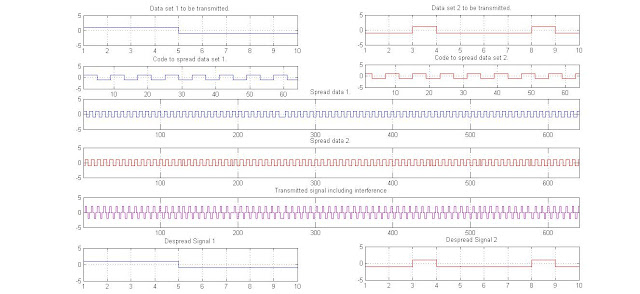For the reciever to be able to demodulate the recived signal, the reciever clock and the transmitter clock need to be in sync. So this is why the reciver clock and the transmitter clock are extremely stable and accurate. This would work well if the reciver was right next to the transmitter, but in most cases they are not very close at all. Therefore there is a time uncertainty.
This is the formual for the time delay, where N is the number of chips in the spreading code and Tc is the time taken for on chip.
So if we were to search over the time uncertainty inerval in time steps of 1/2Tc, then the time required to establish initial synchronization is:
A year two project by group 136. We will look into the basic concepts of how wireless communication (3G in particular) is transmitted securely and discretely by using methods such as modulation with pseudo code to transform the signal basically into 'random' noise.
Thursday, 28 February 2013
Wednesday, 27 February 2013
Testing with multiple users
Here we have the results of using 2 separate users with different spreading codes and data. The blue coloured plot represents the components for User 1 and the red coloured plots represent the components for User 2. The combined spread signal or 'interference pattern' is purple. The basic method of receiving the original data from the interference pattern is to multiply the pattern with the original spreading code, and then divide the signal by however many users are in the interference signal.
Thursday, 21 February 2013
Walsh code spreading
Thursday, 14 February 2013
Pseudo Noise
The pseudo noise is generated using an algorithm based on inputted numbers and this 'noise' is multiplied with the data that needs to be transmitted to produce a 'spreaded' version of the signal. The spreading of the signal usually transforms the signal into one that is below the natural noise level. This makes the signal hard to trace and intercept or scramble.
| Spread Signal below noise level |
There are a few pseudo noise techniques that are used for CDMA, such as; Gold Codes, Walsh- Hadamard Code, M-Sequence Code, Barker Code and Kasami Code.
We will be focussing mainly on Walsh- Hadamard Code and M-Sequence Code.
Subscribe to:
Comments (Atom)



